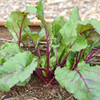Bull's Blood Beet Seeds - (Beta vulgaris)
- SKU:
- V1020
- Seed Count:
- Approx 150 seeds per pack
- Days to Maturity:
- 35 days for baby leaf tops; 55 days for edible roots.
- Days to Germination:
- 5-10 days @ 55-80F
- Plant Spacing:
- 4-6"
- Light Preference:
- Full sun
- Soil Requirements:
- Sandy loam
- Status:
- Heirloom, Non-Hybrid, Non-GMO seeds
Description
Bull’s Blood Beet – Memorable Flavor and Color
Bull’s Blood beet is an exceptional dual-purpose heirloom with deeply flavorful, gorgeous leaves maturing from green to vibrant merlot-red. Freshly harvested young beets are tender with a rich, earthy, sweet flavor. When sliced, the slightly flattened, globe-shaped roots show off colorful circular striations of pink and magenta.
Bull’s Blood is often the winner of taste tests in both beet greens and the roots, with a flavor most often described as sweet and nutty with never a hint of a sharp or bitter aftertaste.
Even though it is considered to be a cool-season vegetable, its quality lasts all summer, and the color deepens as it grows, especially in cool conditions in fall or mild winters.
Details
Bull’s Blood is as eye-catchingly ornamental as it is tasty. The deliciously sweet leaves are perfect for salads or can be used as baby greens at about 35 days. The leaves are broader than most beet varieties and have a particularly sweet taste when harvested young.
This gorgeous beet is a perennial favorite among beet lovers because it provides a consistently rich and sweet flavor from year to year.
Selected and refined by Dutch seedsman Kees Sahin from a selection of the ancient cylindrical French beet ‘Crapaudine’ for its deep, rich flavor, it was introduced in 1986 and was immediately a new favorite of American gardeners.
In Sweden, Bull’s Blood beets are the only variety that can be legally used to make red food coloring.
History
Beets are an ancient food for humans, most likely domesticated somewhere along the Mediterranean, possibly coastal Europe, in the second millennium BC. Today the wild beet, Beta vulgaris maritima is a common seaside plant in southern and western Europe. It arrived in Babylonia through trade in the 8th century BC and as far east as China by 850 AD.
The writings of Aristotle and Theophrastus suggest the beet was grown primarily for its beet greens, or leafy tops, for most of its history, though beet greens lost much of their popularity following the introduction of spinach around 850 AD.
The Romans liked both beet greens and the roots. To the Romans, beets were a food staple, and they introduced a white beet variety into Northern Europe, which the Celts grew. The first mention of a red beet was in the 13th century in northern Italy, and it wasn’t until the 17th century that the red beet became the main type in Europe.
Uses
Young, tender Bull’s Blood beets are hearty and delicious whether they are grated raw in salads, steamed and chilled, or roasted. Beet tops, or greens, are perfect additions to salads.
For a special taste treat, roast whole beets on a covered BBQ grill over medium heat until fork-tender. This smokes and cooks them slowly, deepening their flavors and caramelizing the sugars. Once chilled, serve them thinly sliced on a cracker with crumbled goat cheese and a drop of raspberry vinaigrette. Truly delicious and memorable!
Beets pair well with a wide variety of ingredients, spices, and other vegetables including cheese, bacon, prosciutto, shallots, eggs, dill, paprika, smoked fish, walnuts, garlic, chives, citrus, hazelnut, pistachio oil, and vinegar.
They are also delicious when pickled, offering an incredible flavor profile while also extending the beets’ shelf-life. One of our clearest memories of pickled beets was a Polish beet recipe that was slow-smoked for a full 24 hours, then pickled in crocks and buried in the ground for 6 months. They were served cold, and each flavor slowly unfolded on the tongue and in the mouth, building on each other.
Planting Tip
Direct-sow Beet seeds as soon as the soil can be worked in the spring when the soil has warmed to about 50°F and through the summer for successive crops.
Harvest Tip
While the beets are growing you can pick up to a third of the leaves and use them fresh or cooked. When the roots are 2-3” in diameter, start harvesting them. Pull or dig them up, and cut off the stems to prevent dehydration from starting.
Companion Planting
Beets add minerals to the soil. Plant along bush beans, Brassicas, corn, garlic, kohlrabi, leeks, lettuce, and mint. Avoid planting beets near pole beans, as the nitrogen fixed by the beans may encourage leafy beet growth and diminished root development.
Learn More
From the soil to the seed to the food you eat - we'll help you grow your best garden!
1 Review
-
Did very well in our garden
The Master Gardeners at the historic Francis Land House Heirloom Vegetable Garden in Virginia Beach, Virginia are providing feedback on the donated seeds. Our garden consists of 35 raised beds, each four feet by twenty feet. The garden receives full sun all day and is fertilized with a combination of compost and commercial organic fertilizer. Beets in general do very well in our garden, both in the spring and again in the fall. This variety is no exception, producing a good quality root. We alternated rows of Bulls Blood with Chioggia and got a nice contrast between the dark red leaf of Bulls Blood and paler, lighter green leaf of Chioggia.















